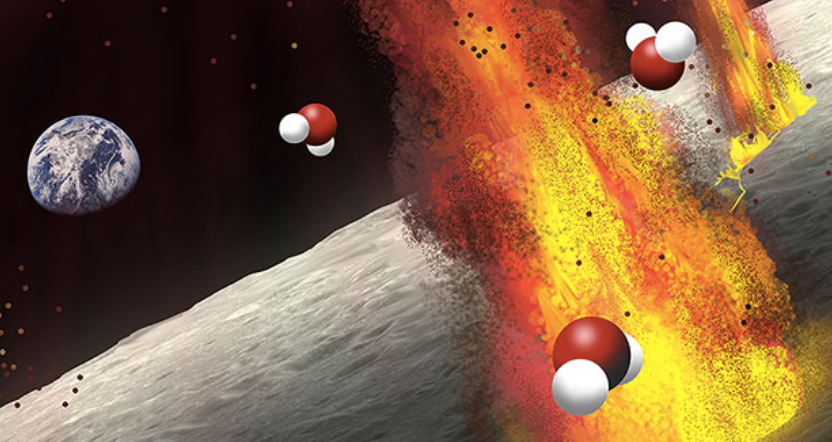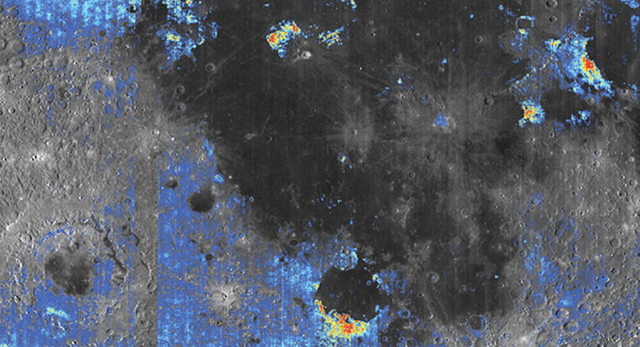Water in the interior of the moon is a mystery
Volcanic moonstone contains water - but where does it come from?
Origin unsolved: The mantle rock of the moon could contain considerably more water than previously assumed. This is confirmed by spectral analyzes of volcanic deposits on the lunar surface. The problem: According to current theory, the lunar center should be dry because all water evaporated in a catastrophic collision even before the moon was formed. The origin of the water that has now been detected is therefore puzzling, as the researchers in the magazine "Nature Geoscience" explain.

Volcanic eruptions on the moon brought watery rock to the surface. This proves that the lunar interior contains more water than thought.
The moon was developed in theory by the collision of the young earth with a mars-sized protoplanet some 4.5 billion years ago. Large quantities of rock evaporated and then solidified again. The moon formed from these ruins. But there is a catch: If this scenario is true, then the moon rock should be extremely dry. For all the water had already evaporated during the collision of its building blocks.
But analyzes of rock samples from the Apollo missions contradict this: In investigations of volcanic moon rock, researchers discovered a surprisingly high water content several years ago. This suggests that the mantle of the moon could be more water-rich than hitherto thought, because the lunar volcanic rock was transported from this layer to the surface.
Are the Apollo samples representative?
"The key question is whether the Apollo samples really reflect the conditions of the entire interior of the moon," explains Ralph Milliken of Brown University. Because the moon rock comes only from a small area on the moon, all the rest is so far untested. To clarify how it looks in this remnant, he and his colleague Shuai Li have now evaluated the data of the Moon Mineralogy Mapper of the Indian moon probe Chandrayaan-1.
"Looking at the orbital data, we can study the large pyroclastic deposits on the Moon that have never been directly sampled," says Milliken. The researchers used the spectral signature of these rocks to determine how much water contained tiny glassy inclusions in the primeval lava lava.
Water signatures almost everywhere
The result: In almost all volcanic deposits on the moon, the researchers found traces of water. "On average, these rocks contain water levels of up to 150 parts per million (ppm), locally, the values reach 300 to 400 ppm," Milliken and Li report
"The fact that almost all these rocks show water signatures suggests that the Apollo samples were not an anomaly," explains Milliken. "And if lunar pyroclasts are generally water-rich, the same should apply to the lunar mantle."

Blue areas characterize rock deposits with increased water content on the lunar surface.
Origin of water puzzling
But where does this lunar water come from? According to current theory, this water should not have survived the catastrophic collision of the early earth. The moon, therefore, must have been made of bony-dry fragments. "Where the water comes from inside the moon is therefore a big question," says Li.
"The increasing evidence of water in the interior of the Moon indicates that the original water must have survived somehow," says the researcher. This would also explain why the isotope signature of the water in the lunar samples coincide with those of terrestrial water, as researchers noted a few years ago.
Another possible explanation would be the impact of water-rich comets and asteroids shortly after moon formation. Because at that time the moon was not completely cold and frozen, the chunks could have penetrated into the moon coat. The water came into the lunar coat.
Useful for astronauts
The newly discovered lunar water could have a very practical use for future space travel missions. Because the inhabitants of the moon stations could get the water they need from the rock. "There is also water ice in the shadows of the lunar poles," says Li. "But the pyroclastic deposits lie in areas that are much better to reach for astronauts."
Even if the volcanic rock contains only about 0.05 percent by weight of water, its extraction could therefore be worthwhile. "Anything that would save future moon visitors with a lot of water from the earth is a big step forward," says Li. "And our results open up a new alternative."